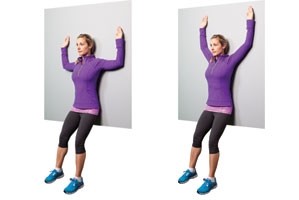
Slumping and slouching isn't sexy. Our posture exercises will show you how to correct your posture so no one will call you a slouch again!
Slumping and slouching isn't sexy. Our posture exercises will show you how to correct your posture so no one will call you a slouch again!
Training our postural muscles isn’t sexy. We don’t start a posture program thinking, “Hey, this is gonna make me look good in my skinny jeans!” Instead, we are often forced to by our chiropractor, physiotherapist, massage therapist, or trainer.
Healthy spine, healthy life
An aligned spine protects our joints by placing less stress on them. This results in efficient movement patterns and less pain, and could also prevent future health problems such as arthritis and back pain.
Three keys to being slouch free
According to physiotherapist Paul Brown of Gordon W. Stokes Physiotherapy, it is important to address three key areas when training your posture muscles: mobility, stability, and strength.
You need mobility of the thoracic and lumbar spine (upper and lower back) for optimal range of motion, as well as to facilitate good breathing.
Stability is key because you need the ability to control the position and the movement of your core, while at the same time you need to strengthen the key muscles related to posture. You can’t have one without the other.
Major players
There are many different muscles that should be targeted when addressing the three key areas of posture. These include the muscles of the rotator cuff, mid and lower trapezius, low back extensors, glutes, and the transverse abdominus.
Meanwhile, you need to keep your hip flexors, pectorals, anterior deltoid, piriformis, hip adductors, hamstrings, abdominals, muscles along the sides of the neck, and even the calves stretched and flexible. In other words, the whole body needs to be trained as a unit.
Mobility
Wall slide

2. Position the backs of your hands against the wall (in a “stick ‘em up” position), and pull your abdominals in so that your low back is pressing into the wall too.
3. Keeping everything pressed against the wall (low back, back of head, backs of hands), slide the backs of the hands straight up and down the wall. Focus on drawing the shoulders down and together as your hands slide back down.
4. Perform 10 to 20 times, pausing at the top and bottom part of the exercise. Rest 30 seconds and then repeat. This is also a good warm-up exercise before an upper body routine in the gym.
Angry cat, happy cat

2. Round your back toward the ceiling, while at the same time tucking your chin into your chest and rolling the tailbone under. Press hard with your hands into the ground to create as much stretch as you can.
3. Slowly reverse the stretch and allow the tailbone to point up to the ceiling while the low back sags and head looks up.
4. Pause for a breath and repeat 4 to 8 times. These can be done daily, and as a warm-up before an abdominal workout.
Stability and strength
Plank with tap outs

2. Straighten your legs and lift your body up and off the ground so that you are hovering in a straight line.
3. While maintaining a neutral spine and keeping the hips still, slowly tap your straightened left leg out to the side and back to the centre again. You do not have to tap out wide, just enough to throw your balance and centre off.
4. Do 10 times and then switch legs.
Swimming extensions

2. Slowly lift your upper torso up off the floor while at the same time circling the arms down to your sides. Keep the palms facing down, your chin tucked in, and your toes gripping the floor throughout.
3. Circle your arms back to the start position as you lower your upper torso back to the ground.
4. Perform 15 to 20 repetitions.
Stretch
Over the chair

2. Feet planted on ground, bum pushed right back, and your hands behind your head, look straight ahead and slowly extend over the back of your chair, draping your body over the top. Keep your chin tucked in while you look up to the ceiling.
3. Pull your elbows back at the same time and feel the stretch across the chest, fronts of shoulders, abdomen, and spine.
4. Hold for 15 to 30 seconds and repeat when you feel the need to sit up tall.
5 quick posture tips
1. Never sit on your wallet. Sitting with one cheek higher than the other will inevitably lead to low back pain.
2. Don’t sleep on your stomach. Our necks are designed to relax when positioned straight ahead.
3. Don’t stand all day, or sit all day. Our bodies are built for movement. Do one thing for long periods of time, and bad posture will be inescapable.
4. Don’t tilt your head back to see through your glasses. If you wear bifocals you are probably guilty of this. Unfortunately, tilting your head like this causes some of the muscles in the neck to slacken and others to tense.
5. Don’t lift weights with poor posture. Whatever posture you train in is the same posture that you will encourage your body to strengthen in.




